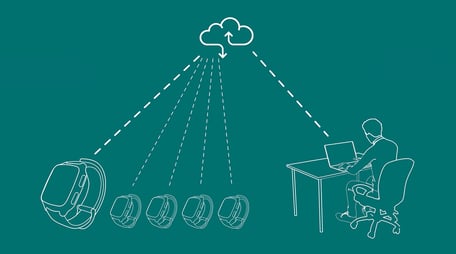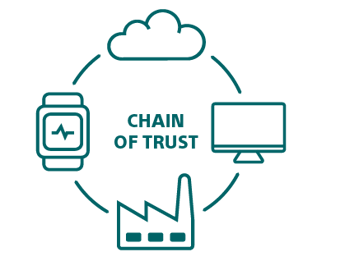Managing mSafety device fleets
Why Sony uses Firmware-Over-The-Air (FOTA)
Keeping wearable devices updated is something that service providers require and end users expect. However, most of today’s consumer wearables use Bluetooth to Smartphone for cloud connectivity and FOTA. While this is relatively easy for an individual managing a personal fitness device, it can pose difficulties for the elderly or physically impaired and is certainly impractical for a service provider with a large fleet of wearables.
mSafety is unusual among wearable devices in that it is designed to connect directly to the mobile network. This means it does not have to be paired with a connected device in order to receive updates. It is always connected automatically, which means it can transfer data and receive software updates at any time.
FOTA is the mobile software management technology provided by Sony Network Communications Europe to enable B2B customers (health & safety service providers) to update the operating firmware of their mSafety wearables. We chose FOTA because it gives the highest levels of convenience, efficiency and flexibility. In addition, it is a secure way to manage and update wearables, remotely and seamlessly, on any scale.
FOTA employs small data packages that are wholly consistent with our mSafety philosophy of minimal data transfer and extended battery life. This minimises download times, power consumption and bandwidth requirements.
Since FOTA packages are pushed to the device, updates run unobtrusively in the background and do not require any intervention by the end users. Should they want to, service providers can request consent from users to download and install new software, but this is optional.
Consider the example of a pharmaceutical company running a long-term clinical trial with hundreds of volunteers using remote monitoring devices. For customers like these, it’s crucial to know what firmware is in the wearables their study groups are using at any given moment. If the participants themselves had to conduct their own firmware updates, it would be difficult for the trial organisers to maintain control.
The combination of FOTA and always-on connectivity makes mSafety highly flexible. At the highest level, FOTA makes it easy to keep firmware up to date. This ensures the device is operating correctly and incorporates the latest security measures. Drill down, however, and FOTA opens up new opportunities.
For example, service providers can remotely install new apps and updates, features and services on wearables that have already been deployed. This means they can control exactly which app is being used by their patients or clients, and be sure to deliver the best application for each user‘s needs.

All this is possible, without making any demands on end users. Unlike with Android- or Apple-based systems, the end user doesn’t have to define his or her own use case, or even connect to external sensors via Bluetooth (i.e. pair their device with a smartphone). The mSafety connection is prepared from the back-end, as is the user definition. So, service providers can pre-package everything they need from the back-end.
Service providers usually want to collect roughly the same type of data from the wearable device, regardless of who’s using it. Insights based on the users’ data, generated by the cloud service, are then sent back to the end user for further interaction. The ability to offer different types of user-interaction can lead to better adherence of usage.
This is a huge advantage when, for example, end users have some kind of physical impairment or are not confident with technology. A user with rheumatism, for example, would most likely find it easier to manage a touch-screen interface, whereas someone with Parkinsons’ would typically prefer actual buttons.

Furthermore, service providers can modify any number of devices separately. Fleets can be divided into groups, each with its own FOTA update pattern or application. A group can include hundred of users, or be as small as one. A care home, for example, might move mSafety devices from one user to another with different requirements. FOTA makes it easy for them to remotely install a different app for each person, each time.
For Sony partners who want to configure an application remotely without updating the software, mSafety offers a feature called Shadow as a complement to FOTA. Using Shadow, it’s possible to change how the software behaves, as opposed to changing the software itself.
This enables very specific and precisely targeted adaptations for certain user groups or even for individual users. For example, how frequently the device measures an individual patient’s heart rate can be adjusted, or a single trial participant can be reminded to take his or her medication.

FOTA updates must of course be made in a secure way, which is why mSafety has an inbuilt root of trust that ensures only FOTA packages signed by the service provider can be installed on a device. Any unsigned package is automatically rejected. Even the mSafety team itself cannot install applications on customers’ devices via FOTA. The service provider therefore has total control.
FOTA gives mSafety customers effortless control over their device fleets and the freedom to make changes or updates without involving end-users. Enabling efficient, timely and consistent firmware updates, this makes life easier for end users and reduces the need for technical support. All these things make FOTA a valuable device management mechanism for owners of larger wearable fleets, and explain why we chose FOTA for the mSafety platform.